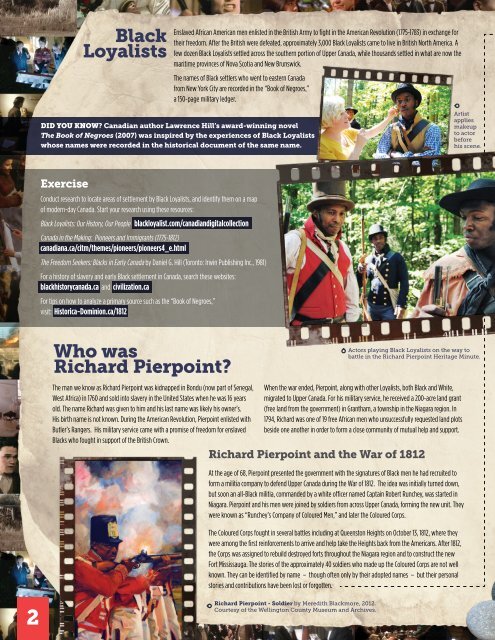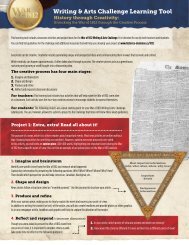Richard Pierpoint - Historica
Richard Pierpoint - Historica
Richard Pierpoint - Historica
You also want an ePaper? Increase the reach of your titles
YUMPU automatically turns print PDFs into web optimized ePapers that Google loves.
Black<br />
Loyalists<br />
Enslaved African American men enlisted in the British Army to fight in the American Revolution (1775-1783) in exchange for<br />
their freedom. After the British were defeated, approximately 3,000 Black Loyalists came to live in British North America. A<br />
few dozen Black Loyalists settled across the southern portion of Upper Canada, while thousands settled in what are now the<br />
maritime provinces of Nova Scotia and New Brunswick.<br />
The names of Black settlers who went to eastern Canada<br />
from New York City are recorded in the “Book of Negroes,”<br />
a 150-page military ledger.<br />
DID YOU KNOW? Canadian author Lawrence Hill’s award-winning novel<br />
The Book of Negroes (2007) was inspired by the experiences of Black Loyalists<br />
whose names were recorded in the historical document of the same name.<br />
Artist<br />
applies<br />
makeup<br />
to actor<br />
before<br />
his scene.<br />
Exercise<br />
Conduct research to locate areas of settlement by Black Loyalists, and identify them on a map<br />
of modern-day Canada. Start your research using these resources:<br />
Black Loyalists: Our History, Our People blackloyalist.com/canadiandigitalcollection<br />
Canada in the Making: Pioneers and Immigrants (1775-1812)<br />
canadiana.ca/citm/themes/pioneers/pioneers4_e.html<br />
The Freedom Seekers: Blacks in Early Canada by Daniel G. Hill (Toronto: Irwin Publishing Inc., 1981)<br />
For a history of slavery and early Black settlement in Canada, search these websites:<br />
blackhistorycanada.ca and civilization.ca<br />
For tips on how to analyze a primary source such as the “Book of Negroes,”<br />
visit: <strong>Historica</strong>-Dominion.ca/1812<br />
Who was<br />
<strong>Richard</strong> <strong>Pierpoint</strong>?<br />
Actors playing Black Loyalists on the way to<br />
battle in the <strong>Richard</strong> <strong>Pierpoint</strong> Heritage Minute.<br />
The man we know as <strong>Richard</strong> <strong>Pierpoint</strong> was kidnapped in Bondu (now part of Senegal,<br />
West Africa) in 1760 and sold into slavery in the United States when he was 16 years<br />
old. The name <strong>Richard</strong> was given to him and his last name was likely his owner’s.<br />
His birth name is not known. During the American Revolution, <strong>Pierpoint</strong> enlisted with<br />
Butler’s Rangers. His military service came with a promise of freedom for enslaved<br />
Blacks who fought in support of the British Crown.<br />
When the war ended, <strong>Pierpoint</strong>, along with other Loyalists, both Black and White,<br />
migrated to Upper Canada. For his military service, he received a 200-acre land grant<br />
(free land from the government) in Grantham, a township in the Niagara region. In<br />
1794, <strong>Richard</strong> was one of 19 free African men who unsuccessfully requested land plots<br />
beside one another in order to form a close community of mutual help and support.<br />
<strong>Richard</strong> <strong>Pierpoint</strong> and the War of 1812<br />
At the age of 68, <strong>Pierpoint</strong> presented the government with the signatures of Black men he had recruited to<br />
form a militia company to defend Upper Canada during the War of 1812. The idea was initially turned down,<br />
but soon an all-Black militia, commanded by a white officer named Captain Robert Runchey, was started in<br />
Niagara. <strong>Pierpoint</strong> and his men were joined by soldiers from across Upper Canada, forming the new unit. They<br />
were known as “Runchey’s Company of Coloured Men,” and later the Coloured Corps.<br />
The Coloured Corps fought in several battles including at Queenston Heights on October 13, 1812, where they<br />
were among the first reinforcements to arrive and help take the Heights back from the Americans. After 1812,<br />
the Corps was assigned to rebuild destroyed forts throughout the Niagara region and to construct the new<br />
Fort Mississauga. The stories of the approximately 40 soldiers who made up the Coloured Corps are not well<br />
known. They can be identified by name – though often only by their adopted names – but their personal<br />
stories and contributions have been lost or forgotten.<br />
2<br />
<strong>Richard</strong> <strong>Pierpoint</strong> - Soldier by Meredith Blackmore, 2012.<br />
Courtesy of the Wellington County Museum and Archives.




